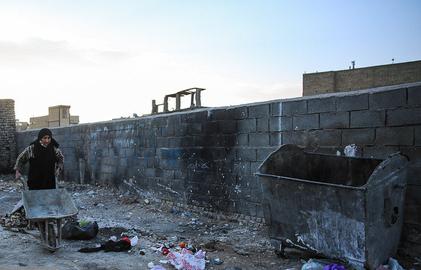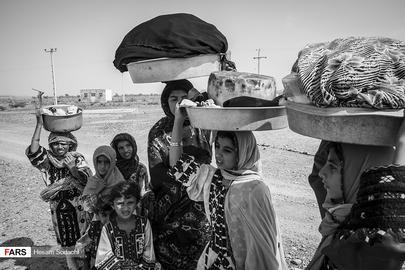What is it like to live on the margins of a metropolis in Iran today? Those who do are confronted with some of the most serious crises facing the country today, with social, economic, political and security repercussions. Various groups and organizations have reported on and collected data about the predicaments of margin-dwelling in Iran but, despite the significance of the subject, the reliable statistics needed for in-depth political, social and economic analyses either do not exist or have not been made public.
This is the third in a series of reports on living on the margins in Iran. Previously, we looked more broadly at the northeastern Iranian province of Razavi Khorasan. Here we look in depth at margin-dwelling in the county's biggest city, Mashhad, as well as in other cities in the province. IranWire will aim to use available statistics and data, as incomprehensive some of it might be, to arrive at an accurate picture of the phenomenon of living on the margins in Iran and the crises emerging from it.
IranWire’s previous article about Khorasan Razavi highlighted what makes this province and its capital Mashhad especially important in the context of margin-dwelling. Here IranWire looks specifically at margin-dwelling in the province, particularly in Mashhad, where around half of the population of the province lives.
According to our estimates, more than 1.45 million residents of Mashhad, or around half of its population, and 330,000 residents of other cities of the province, live in decayed urban environments, in unauthorized dwellings or outside city limits.
Margin Dwelling in Mashhad
Mashhad is a unique phenomenon in the eastern part of Iran. As the media and academic studies have reported, while most eastern cities face harsh and worsening economic and environmental crises, for many, living on the margins of Mashhad is extremely difficult, but also a significant accomplishment. Many people come to the city from other decaying urban or rural environments, and when life in these places becomes impossible, a miserable life on the margins of cities like Mashhad makes perfect sense, economically and/or environmentally.
To begin looking at margin-dwelling in Mashhad, it is useful to look at the numbers and statistics about the area to gain an accurate context and overall picture.
1. Mashhad’s Decayed Urban Areas
According to a report by Mashhad Municipality published in 2014, the total of decayed urban areas in the city came to more than 23 square kilometers, in which around 535,000 people lived. If we assume that the population increase in these areas matches the overall increase of Mashhad’s population, then today close to 600,000 live in these areas. The report identified more than 53 neighborhoods as being “decayed.”
The report used three indicators for flagging an area as being in a state of decay:
- Small granularity: The plots where people live are small.
- Instability: The structures lack physical stability.
- Inaccessibility: Passages are too narrow, impeding access for emergency vehicles and services.
It follows that decayed urban areas are not necessarily where only migrant and low-income people live; this category also includes old neighborhoods that, regardless of their cultural or financial value, are vulnerable to earthquakes, fire and other natural or social disasters. For example, Samen District in the center of Mashhad and adjacent to the shrine of Imam Reza is valuable in historical, cultural and commercial terms but is considered a decayed urban zone. In 2011, this district was home to more than 16,500 people.
2. Unauthorized Dwellings
The term “unauthorized dwellings” is a more accurate term to describe where margin-dwellers live. According to the official definition in Iran, this term applies to all residential buildings constructed outside city limits and metropolitan areas and which are not included in the approved development plans. These dwellings are predominantly home to migrants and low-income people who cannot afford to live in the city proper and have no other option but to live in shantytowns. The overwhelming majority of these dwellings are jury-rigged and without safeguards. Since they have been built without legal authorization, the people living there do not benefit from various services — from water, gas and electricity to emergency medical services and police protection. As a result, they are not only vulnerable to natural or man-made disasters such as fire, floods or earthquakes, they also lack protection against crime.
Another report from Mashhad Municipality based on the 2011 census estimates that unauthorized dwellings cover 40 square kilometers, housing fully one-third of Mashhad’s population — 883,000 people, including more than 110,000 children under the age of six. If, optimistically, we assume that the rate of population increase in these areas matches that of Mashhad itself, then at this juncture more than one million people are living in these shantytowns. According to the report, unauthorized dwellings exist in 66 neighborhoods, covering about 13 percent of Mashhad’s surface area.
3. Dwellings Outside City Limits
According to statistics published by Mashhad Municipality based on the 2011 census, 3,070 hectares outside city limits — meaning in rural areas surrounding Mashhad — are residential, where more than 143,000 people live. If we assume that the population in these areas has increased at the same rate as that of Mashhad, then its population must now stand at 150,000.
Population density in these areas is close to 5,000 per square kilometer. For areas where people live in one- or two-storied houses, this is a very high density. And since these areas are deprived from various city services, the residents must be considered margin-dwellers.
How Many Margin Dwellers in Mashhad?
Based on reports published by Mashhad Municipality, decayed urban areas and areas with unauthorized dwellings partially overlap, but they are not the same. There is no way that the official statistics provide an exact and indisputable answer, but if it assumed that at least half of the population of decayed urban areas are living in authorized dwellings, then we arrive at a total of around 1.3 million who live in shoddy housing within the city limits of Mashhad.
But realistically, it is reasonable to add another 150,000 people who live in the rural areas immediately outside city limits as well. In this case, the figure arrives at a total of 1.45 million and, since the latest census put the population of Mashhad at over three million, close to half of Mashhad’s population fell within the category of “margin dwellers”.
Where Do Mashhad Margin-Dwellers Come From?
Mashhad Municipality has published statistics about where migrants who arrived between 2006 and 2011 came from and maps showing their distribution among the city’s neighborhoods. According this map, part of these migrants are living in decayed urban areas and in unauthorized dwellings.
The origin of migrants by itself cannot provide a true picture of Mashhad’s ethnic texture but it does give us an idea who these migrants are.
From 2006 to 2011, more than 190,000 people migrated to Mashhad. In 2006, the population of Mashhad was 2.427 million. According to 2011 statistics, the population had reached 2.766 million — an increase of 339,000. By comparing this number with the number of migrants during the same period, we find that only 44 percent of the increase was due to native births and the rest was made up by migrants.
Statistics show that 105,000 of migrants came from other parts of Razavi Khorasan, not from Mashhad, or from other provinces. The share of other provinces, in rounded numbers, is as follows:
- Tehran: 15,000
- Sistan and Baluchistan: 10,000
- North Khorasan: 9,000
- South Khorasan: 6,000
- Golestan and Mazandaran: 5,000 together
- Khuzestan: 3,000
- Kerman and Isfahan: 2,800 each
- Fars: 1,800
- Yazd: 1,600
- Hormozgan, Qom and Alborz: 1,500 each
- Gilan: 1,000
- Other provinces: less than 1,000 in total
Adding together the number of migrants from eastern Iranian provinces, it turns out that more than 75 percent of migrants to Mashhad came from provinces in the eastern part of Iran. The share of foreign immigrants who moved to Mashhad in these five years was 4,650 or less than 2.5 percent. The total of foreign nationals migrating to Mashhad in 2011 was more than 136,000.
Razavi Khorasan’s Major Cities (Source: Google Maps)
Margin-Dwelling in Other Cities in Razavi Khorasan
Razavi Khorasan province is comprised of 28 counties and 53 cities. In 2016, seven of these cities had populations of over 100,000. The most populous city in the province after Mashhad is Neishabur, with 264,000 inhabitants. Then come Sabzevar, Torbat-e Heydarieh, Kashmar, Quchan, and Torbat-e Jam.
A look into the statistics on these cities shows that the depth of margin-dwelling in them is not much more shallow than in Mashhad. A study conducted in 2008 arrived at the following numbers for margin-dwellers and their percentage of the total population of the city:
- Neishabur: Over 25,000 or 12 percent
- Sabzevar: Over 23,000 or 11 percent
- Torbat-e Heydarieh: 20,000 or 17 percent
- Gonabad: 8,000 or 21 percent
If we assume that the increase in the population of margin-dwellers matches that of the population as a whole, then the number of margin-dwellers in Neishabur and Sabzevar must be around 35,000 in each city. These numbers, however, are not indisputable. For instance, according to unofficial statistics, in 2016 Neishabur had more than 60,000 margin-dwellers, an increase of 23 percent or twice the rate of increase for the total population of the city.
But the numbers do not tell the whole story. Sporadic reports give us glimpses of the miserable conditions of these margin-dwellers, some of whom live in tents in the outlying areas of the cities. Also, the conditions are not necessarily worse or better in small cities and they depend on the economy and the urban texture of the city in question. And these conditions change. For instance, a decade ago the rate of margin-dwelling in Gonabad was twice that of Neishabur and Sabzevar.
Nevertheless, in evaluating the conditions of those margin-dwellers who live in decayed urban areas and unauthorized dwellings, we must take into account that in small cities the quality of buildings is usually low and the national regulations and standards are typically ignored. This has contributed to urban decay all across Iran.
If 20 percent of the residents of the cities of Khorasan Razavi live in decayed urban areas and unauthorized dwellings — an assumption that is neither too optimistic or too pessimistic — and this is multiplied by the urban population of the province (except that of Mashhad), the number of margin-dwellers and other residents of these areas rises to over 340,000.
Read the full Living on the Margins in Iran series:
Living on the Margins in Iran: An Introduction
Living on the Margins in Iran: Razavi Khorasan
Living on the Margins in Iran: Mashhad and the Cities of Razavi Khorasan
Living on the Margins in Iran: East Azerbaijan
Living on the Margins in Iran: Bandar Abbas and Hormozgan Province
Living on the Margins in Iran: Chabahar and the Province of Sistan and Baluchistan
Living on the Margins in Iran: The Rise and Fall of Khuzestan
Sources in Persian:
اطلاعات جمعیتی بافت فرسوده شهر مشهد به تفکیک مناطق، نواحی و محلات, Mashhad Municipality (PDF), 2014
اطلاعات جمعیتی و اطلس سکونتگاههای غیررسمی شهر مشهد, Mashhad Municipality (PDF), 2014
آمارنامه شهر مشهد 1394, Mashhad Municipality (PDF), 2015
از چادرنشینی های رو به گسترش در جنوب شهر سبزوار تا تشکیل سکونتگاه های غیر رسمی, Asrar Nameh, November 11, 2017
visit the accountability section
In this section of Iran Wire, you can contact the officials and launch your campaign for various problems

























comments